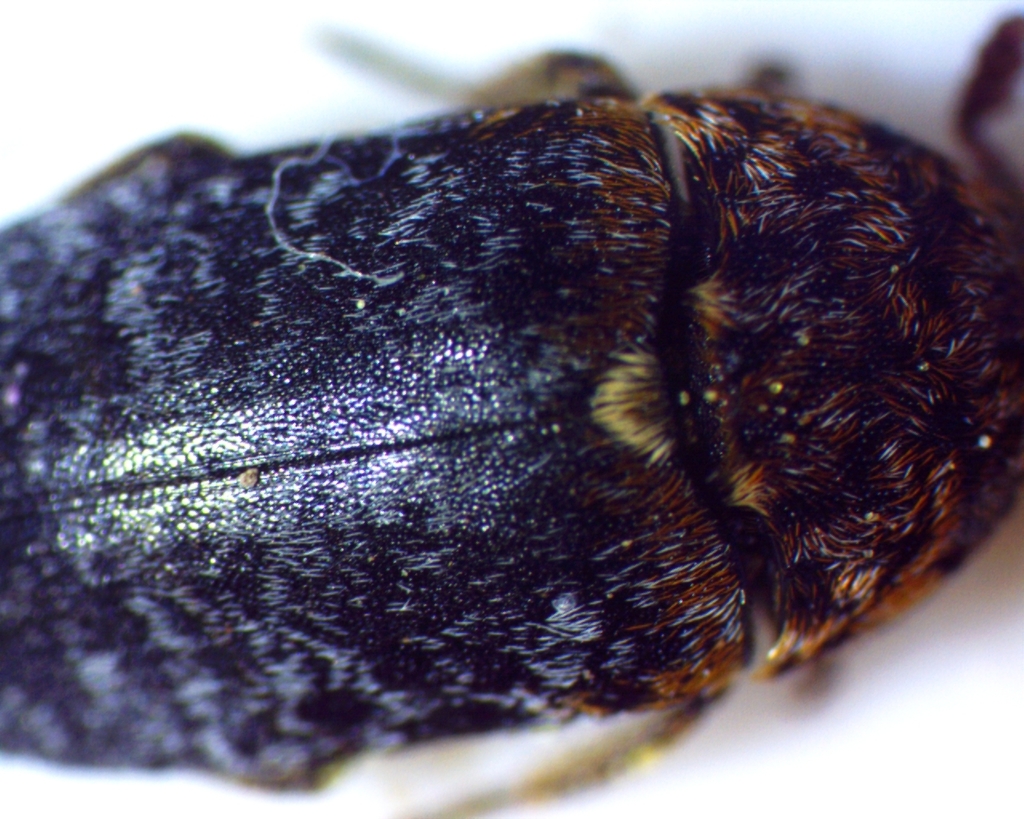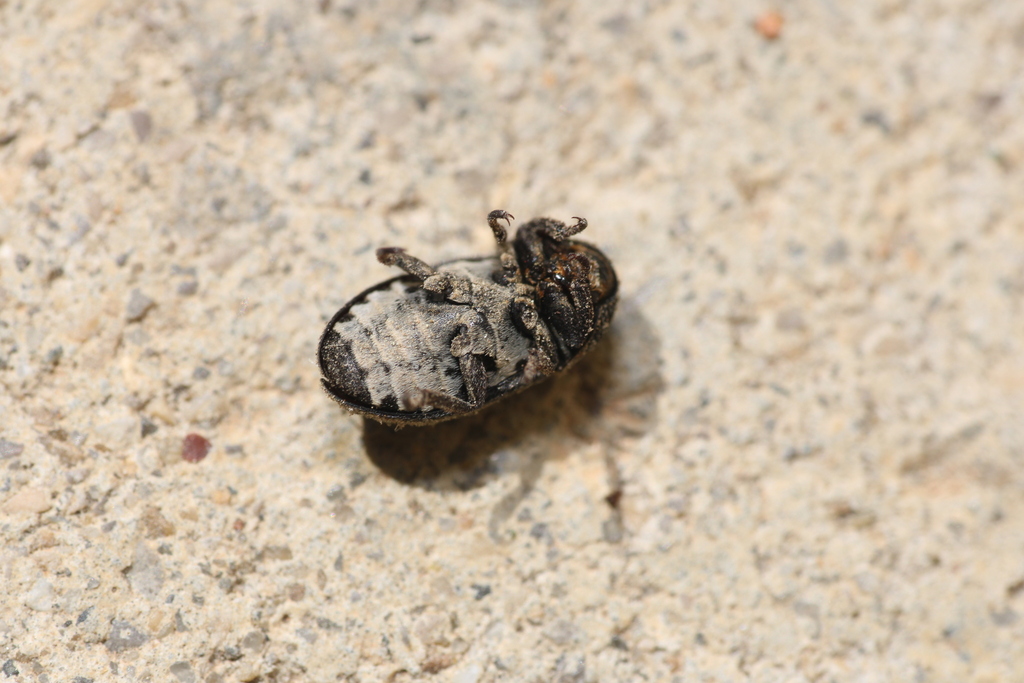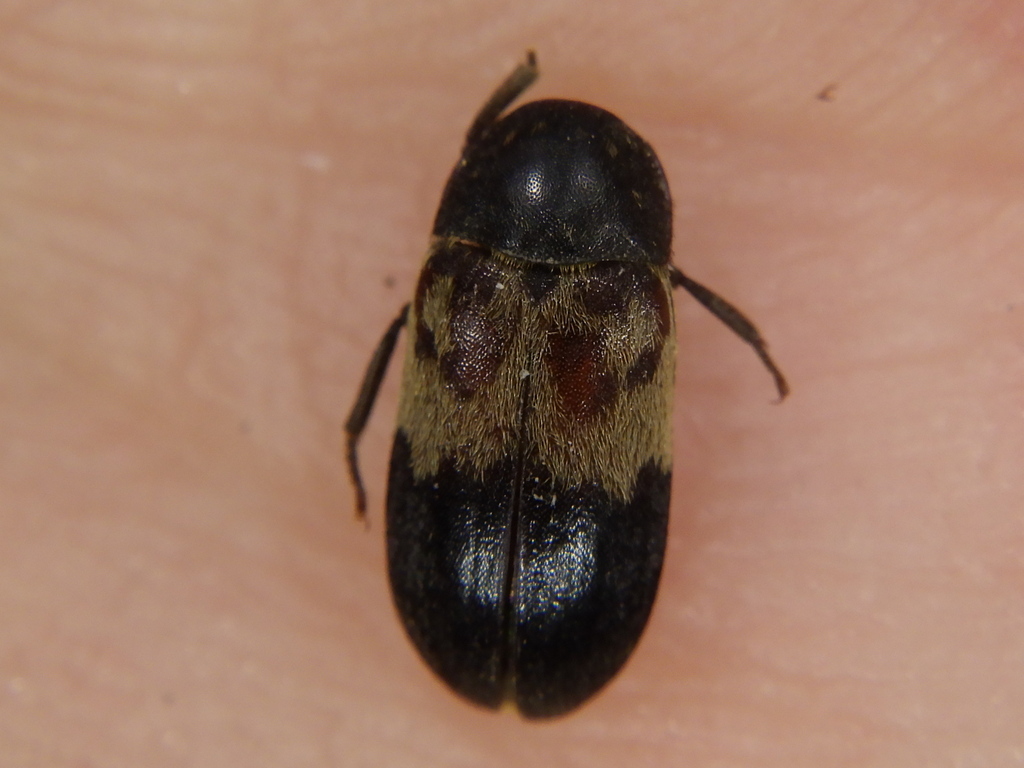Theory
About In Amber
As much as you may have enjoyed the world of In Amber, it has enjoyed you. To be confronted with the empathy of bugs and to discover what that means in a world where the value of life is often misplaced, in humans and other beings alike, can be sobering. My name is Paloma Calvin and I developed this project for the 2024-2025 Thompson Prize facilitated by ArtsEngine at the University of Michigan for the Art/Sci residency. However, my observation of the hidden world of insects began long before the project itself.
In 2020, my fascination started. The original version of the track ‘Attack of Giant Mutant Cicada’ was born as an experiment during COVID-19 lockdowns. In 2023, my interest in bugs was renewed when I started working in Zoology, where my job, in part, was to take care of Dermestid beetle colonies.
Dermestid beetles are a group of beetles that are commonly referred to as “skin beetles.” You might also know them as “carpet beetles,” and perhaps you have even dealt with carpet beetles living alongside you and chewing up your carpet and furniture. Skin beetles, on the other hand, are used in Zoology for a specific purpose — one that is often considered both disgusting and fascinating. Both in the museum and outside of the museum, skin beetles help with decay. They can eat almost anything, but in the wild they tend to eat the remains of animals and are considered detritivores. With many hours alone feeding, cleaning enclosures, watering, and observing the life and purpose of the dermestid beetles, I was inspired by their miniature realities. It was interesting to be in the position to take care of these small animals and to deeply understand that they would not be able to survive if I was not around. Their lives are so different from ours, and yet they require all the same basic things — food, water, and empathy. And, in their own way, they give back, contributing to the cycle of life and the world of science. I found that, over time, I developed a sense of kinship with the little creatures and that bong was one of the main inspirations for this project.
Bugs are often overlooked. They’re viewed as inconvenient, disgusting, annoying, and ugly. Their lives are not given care and they are not spared mercy, often killed in cruel and torturous ways. And yet, we cannot exist without them, and they are a part — however small — of the expansive life on Earth that must be cherished for its rarity and for our own experience of it. Furthermore, when taking a step away from the empathy of bugs and from bugs, I believe that the way we as humans treat bugs is a reflection of how we treat each other on a whole. Those deemed inconvenient, disgusting, annoying, and ugly are treated as such. Although this project is abstract, I hope that you gather from it that the way we define things, whether insects, people, or ourselves, is vitally important to how the world views and treats those things, and that definitions are more than just words. They can be life or death. And even more so in today’s world.
I encourage you to consider the insects around you and to treat them with the kindness you might treat a mammal, a bird, your pets, your friends, or your family, even if that kindness looks different for the bug than your closest companion. We aren’t really all that different, anyway.
Dermestid Beetles



Aren’t they beautiful up close?
Uninspired Art
Inspirations for this project were vast, including early internet web-design and callbacks to such design by my favorite contemporary artists (think Magdalena Bay, Oklou, Hildegard and more). I have always had a tendency toward existentialism and thinking about the absolute scale of things. Insects’ lives are so small and yet their essence has been preserved in time for millenia, longer than humans have even existed, trapped in amber. Climate change and the marathonic time-scales of Earth’s geology, evolution, and celestial forms fed the idea for this project. Similarly, in today’s digital world, thinking about preservation over time and what we can actually consider to be preserved digitally was at the forefront — as insects trapped in amber, can our digital works truly be preserved for years to come when our digital worlds are only in their infancy? And when social, humanitarian, and climate-related challenges threaten that infrastructure?
Though the themes of this project are abstract, I hope that the imagery, lyricism, sampling, and music production evoke those thoughts, feelings, and discourse. The music itself is not necessarily meant to be enjoyed on its own. It’s all about sound design, playing with supertonality and delay and strange rhythms. It also incorporates found sound because all music is ultimately a reflection of the natural world. It is imperfect, because as all of us, I am learning continually about music theory, music production, songwriting, and sound design.
Because of the relative abstraction of this work, its methodology led to my coining of the term Uninspired art. Uninspired art, to me, is not art that has no inspiration but rather art that is self-inspiring, unreplicable, and intentionally imperfect.
I hope you can find solace in such a form, and through this project.
Renaissance of the Concept Album
I was also inspired by the recent revival, or renaissance, of the concept album. Music has always been a medium for thematic expression, and yet the new decade has seemingly been defined by a new era of conceptual music and accompanying visual or spatial works. Take Magdalena Bay as a prime — but not the only — example. Take FKA Twigs’ Eusexua; Ha Vay’s Baby I’m The Wolf, Halsey’s The Great Impersonator among many, many others. With these pieces of concept art come new methods of storytelling which often expand into the ever-present digital world. Visual albums moving beyond one-off music videos into full standalone art projects; interactive websites that expand the digital world’s collective map; transcendent live performances that combine aural, visual, and movement-based technique are among some of the more popular forms although others are emerging by the day. Most examples that I see are within the definition of pop music, and I am eager to see more varied storytelling within different genres. I also hope that by expanding storytelling we can collectively expand the defining boundaries of music itself, changing the way we view and hear music of different genres. One of the ways that technology has a profound impact on society is through its ability to create and transmit methods of storytelling that might otherwise be inaccessible. And the best part about these technologies is that they are always becoming easier to learn, use, and design.
In Amber is meant to be participatory, expanding the viewer’s idea of what it means to tell a story. The how is just as important as the why in many cases. Music, art, and storytelling have always gone hand in hand, and imagining new ways to share and propagate those stories is how we arrive at the future from our shared past.
Acknowledgements
I want to thank all who have supported this project. First, Dr. Matthew Thompson who has provided a year’s worth of invaluable feedback, time, and expertise. The Thompson Prize has been integral to finding joy through creativity during a very tough year, and I’m so thankful to Dr. Thompson for providing the opportunity to learn and create. I also want to thank Ola Ifidon, who is also a recipient of the Thompson Prize. Ola’s words of wisdom, encouragement, and thoughtfulness have been deeply helpful to the project. Ola’s work, ’Sankofa’ was crafted with so much intention and deep understanding, and it very much shows in her work. It has been a pleasure to work with Ola over the past year.
I also want to thank my family and friends who have supported me in this project. In Amber was mixed and mastered by my partner Jack Withers. I am so grateful for his support throughout the year working on this project, as well as his delicate touch with my music. Jack’s music has been a huge inspiration to me for many years and to have put together a project worthy of his mixing and mastering skills is a huge achievement for me!
I also want to thank my parents and my sister Ione for their support. I also want to give Ione a special shoutout for doing vocals on ‘Attack of Giant Mutant Cicada’ in my bedroom all those years ago — who knew it would end up on an entire album almost five years later!
And thank you to many more who have followed along in this journey. I appreciate every single person who has listened, shared, or simply given me encouragement.
With love fossilized through the wires of the digital realm,
Paloma